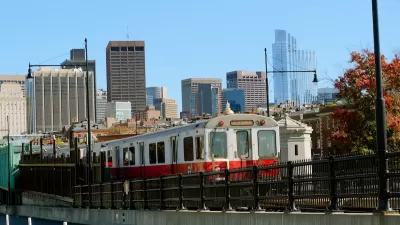One Dalton Street, the third tallest building in Boston, is almost complete.

Robert Campbell, architecture critic for the Boston Globe, writes a column describing Boston's newest skyscraper as a design success.
The building, One Dalton Street, achieves this success despite having "no particular reason to exist," writes Campbell. "With a posh Four Seasons hotel occupying its lower floors and luxury condos in its upper levels — one penthouse has reportedly been sold for $40 million — it’s a place for people who choose to experience the life of a busy urban world while living far above it."
Still, the building is in full command of its details, according to Campbell, to the point of a military comparison. The real magic of the building, according to Campbell, is the building's "powerful sculptural form in play with its surroundings."
The senior architect on the project, Henry Cobb, "studied historic railway lines and street maps of this part of Boston" before realizing that "the land had always been organized as a loose arrangement of triangles." Those triangles are manifested in the floor plans of every level in the building above the fifth.
FULL STORY: One Dalton, Boston’s commanding new skyscraper, conjures architectural magic

Trump Administration Could Effectively End Housing Voucher Program
Federal officials are eyeing major cuts to the Section 8 program that helps millions of low-income households pay rent.

Planetizen Federal Action Tracker
A weekly monitor of how Trump’s orders and actions are impacting planners and planning in America.

The 120 Year Old Tiny Home Villages That Sheltered San Francisco’s Earthquake Refugees
More than a century ago, San Francisco mobilized to house thousands of residents displaced by the 1906 earthquake. Could their strategy offer a model for the present?

HSR Reaches Key Settlement in Northern California City
The state’s high-speed rail authority reached an agreement with Millbrae, a key city on the train’s proposed route to San Francisco.

Washington State Legislature Passes Parking Reform Bill
A bill that would limit parking requirements for new developments is headed to the governor’s desk.

Missouri Law Would Ban Protections for Housing Voucher Users
A state law seeks to overturn source-of-income discrimination bans passed by several Missouri cities.
Urban Design for Planners 1: Software Tools
This six-course series explores essential urban design concepts using open source software and equips planners with the tools they need to participate fully in the urban design process.
Planning for Universal Design
Learn the tools for implementing Universal Design in planning regulations.
Ada County Highway District
Clanton & Associates, Inc.
Jessamine County Fiscal Court
Institute for Housing and Urban Development Studies (IHS)
City of Grandview
Harvard GSD Executive Education
Toledo-Lucas County Plan Commissions
Salt Lake City
NYU Wagner Graduate School of Public Service




























